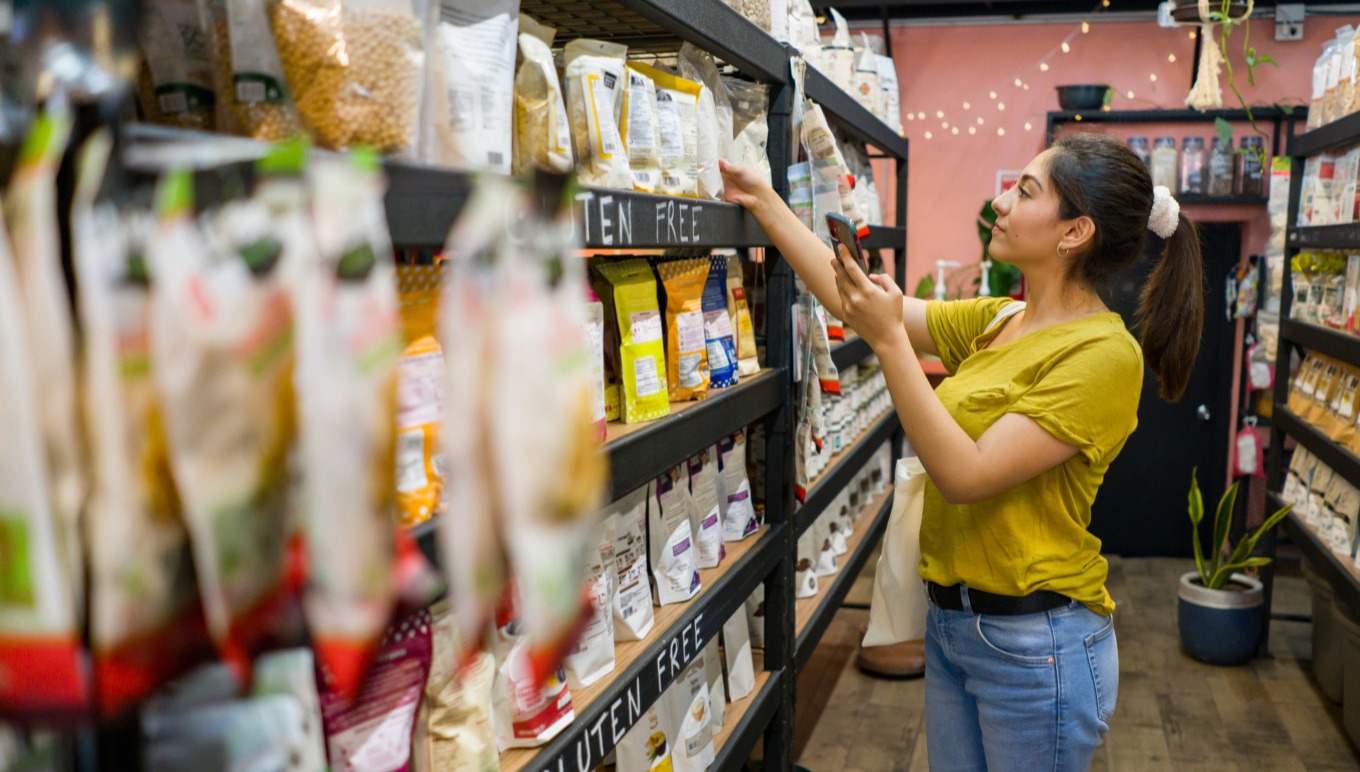Featured in this post
5 Food Industry Trends for 2023 that Demand Your Attention
5 Food Industry Trends for 2023 that Demand Your Attention

Though it may be hard to believe, we’re already in the home stretch of 2022, and that means it’s time for food and beverage businesses to look ahead at the trends that will set the tone and influence the market throughout the next year. In order for you to plan for the future effectively, you need insight into the developments that will shape the industry in the months to come.
The world of food and beverage has undergone its fair share of change over the past few years. Demand underwent a dramatic shift in favor of retail over foodservice during the pandemic, with meal kits and home delivery skyrocketing in popularity. Today, the global economy is in a state of flux, and companies are learning to adapt and operate under a new paradigm.
Meanwhile, technology continues to advance and become more central for both how we live our lives as well as the ways that brands overcome challenges and innovate. While there remains much uncertainty, it’s also an exciting time for sure as there are opportunities for growth across all food and beverage sectors—but it will take a keen understanding of the various factors at play to attain success.
So, to aid you in your efforts to prepare for 2023, we’ve come up with this list of the five food industry trends that demand your attention. We’ll provide some greater context and an idea of what to expect going forward, as well as the ways in which purpose-built food and beverage software solutions give you the tools and functionalities you need to forge forward in this ever-evolving business landscape.
1. Rising Costs
Whether due to raw material shortages or inflation, food and beverage manufacturers are having to deal with higher operating costs. This in turn leads to higher retail prices for consumers—the Bureau of Labor Statistics reports that food-at-home in the U.S. is 13.1% more expensive compared to last year, while the Office of National Statistics found that UK prices are up 14.6% since January 2022—but brands are well aware of the impact that can have on their reputation and are motivated to mitigate the issue.
To drive the point home further, IDC’s Global Food and Beverage Industry Trends and Strategic Insights 2022 whitepaper commissioned by Aptean confirmed that food and beverage executives are concerned about this trend. In the survey portion, inflation ranked as the top external pressure and higher operating costs was predicted to have the biggest impact over the next 5 years.
Thankfully, industry-specific enterprise resource planning (ERP) software has features that help manufacturers save money and optimize profitability. Expiration management tools help to reduce waste, and good production scheduling functionalities keep productivity high so you can meet ambitious sales goals. Aptean's food ERP shines thanks to its Advanced Pricing module, which provides flexibility and the option to use a hierarchical structure for better margins.
2. Supply Chain Disruptions
While stay-at-home orders and border closures no longer restrict the movement of people and goods, supply chain disruptions continue to negatively impact the food and beverage industry. Whether it’s labor shortages on the distribution side or complications from having to switch suppliers due to scarcity, many manufacturers are feeling the need for more resilience in the face of potential difficulties.
The IDC whitepaper gives us further evidence that supply chain struggles are top-of-mind for food and beverage business decision-makers. Of the current gaps that are most likely to be problematic if not addressed, a lack of supply chain visibility and flexibility, combined with the need for adaptability and foresight to react to changes effectively, shared the top spot.
The right food and beverage ERP solution can really make a difference on this front, with production scheduling features that help you align supply and demand in advance and the flexibility to build out multiple production scenarios, including your primary plan and back-ups should unforeseen circumstances arise. Our own system also has a Vendor Item Catalogue module that makes placing replenishment orders easy, efficient and less error-prone.
Inflation is considered the top external pressure for food and beverage manufacturers, and higher operating costs is predicted to have the biggest impact over the next 5 years.
3. Big Data
The fact that mentions of “big data” in the filings of top food manufacturing companies are up 64% since 2016 proves that over time organizations are increasingly turning to statistics and metrics for insight. The value of information has always been noted—the old saying “knowledge is power” stands as a testament to that—but food and beverage brands see this area as an opportunity for growth.
Big data also ranked highly in the list of technologies to have the greatest impact on food and beverage organizations in IDC’s survey, reaching into the top five with other significant advancements like cloud-based networks and applications. Interestingly, it ranked higher with respondents in the IT field compared to their line-of-business counterparts, demonstrating that the concept is intrinsically tied to technology.
For the robust reporting and analytics you need to get the most out of your data, you’ll want business intelligence software built for the food and beverage industry. Aptean Food & Beverage ERP offers a streamlined integration with Aptean Business Intelligence, which tracks some 500 key performance indicators—more than 300 of which are food- and beverage-specific—and can model simulations to inform your decisions.
4. Sustainability
The push for the food and beverage industry to become more sustainable isn’t an entirely new development, but it is picking up steam as consumers’ demands for brands to get greener and be more accountable increase. Business leaders are definitely listening, with 55% reporting that their companies have increased investment in environmental sustainability of late.
For more proof, we can turn to the IDC whitepaper, in which sustainability ranked as the top focus for risk mitigation by a reasonably wide margin. The top motivating factor for the adoption of more sustainable practices was customer demands, while the most widely used strategy for becoming more sustainable was reducing waste and spoilage across the supply chain.
As far as how software can enhance your sustainability efforts, we mentioned before ERPs with effective expiration management features can help you cut down on waste by tracking dates and deploying alerts before ingredients or finished goods spoil. Overall equipment effectiveness solutions can also help minimize scrap during manufacturing processes, and Aptean Process Manufacturing OEE can help you identify these losses in real time so that the root cause can be addressed.
Sustainability is the top focus for risk mitigation, and customer demands are the main motivator for adoption of sustainable practices in the food and beverage industry.
5. Changing Consumer Tastes
The proliferation of new products, varieties and even packaging types shows that the desires of consumers are shifting and manufacturers are responding accordingly. One of the niches that’s most popular and poised for continued expansion would be food and beverage items with health benefits, including those suited for specific diets (like keto and gluten-free) as well as those with more general immunity- and mood-boosting effects.
From the IDC survey results, we can see that changes in consumer demands and preferences was voted as the trend to have the second-greatest impact on the food and beverage industry over the next five years, right behind higher operating costs. Fittingly, respondents working for manufacturers and processors ranked it more highly than those working for distributors—understandable considering most distribution businesses don’t always get to determine exactly what they transport and deliver.
To get in on the action and seize opportunities in emergent product categories, your organization will need to optimize your new product development processes, and there’s no better way than with a product lifecycle management (PLM) solution. Aptean PLM Lascom Edition has the tools you need, with built-in USDA and CIQUAL databases, automatic generation of ingredient lists and nutritional values, advanced formulation functionality and more.
Your Search for the Right Solution Provider Is Over
Here at Aptean, we’re committed to getting our clients Ready for What’s Next, Now® with our complete suite of tailored solutions. Our dedication to the food and beverage market is evident from the decades of collective experience our team members have in the industry and our deep understanding of best practices that businesses like yours need to implement in order to succeed.
For more evidence of our proficiency in the space, consider that our food and beverage ERP was recently recognized by independent consulting firm Frost and Sullivan with their 2022 Product Leadership Award in North American ERP Software for the Food and Beverage Industry Award. We offer flexible cloud deployments on the Software as a Service (SaaS) model too, which unlocks greater scalability, security and mobile accessibility, among other significant benefits.
Our system also has the advantage of industry-specific technology built on the Microsoft Dynamics 365 Business Central platform, which gives it a user-friendly interface and helps to limit the need for extensive training. Finally, you should know that we strive to act as a partner for each and every customer, guiding the implementation process and assisting in the creation of a project roadmap to see you through rollout and beyond.
So, ready to get a head start on 2023 by getting the software you need to keep pace with these top food and beverage industry trends? Contact us today or request a personalized demo.
Aptean Global Food and Beverage Outlook
In this paper, we’re going to discuss how food manufacturers, producers and distributors can prepare for the 6 trends that will influence the food industry in 2023.



 Jack Payne | Vice President, Product Management & Solutions Consulting
Jack Payne | Vice President, Product Management & Solutions Consulting